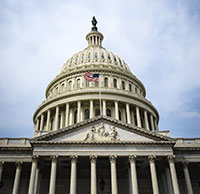Providers Urged to Continue Advocacy Push
Providers called on to contact lawmakers to support legislative initiatives to protect non-invasive ventilators and provide relief to non-rural, non-bid area providers.
- By David Kopf
- Jan 23, 2020
 The American Association for Homecare reminded providers and other HME stakeholders that they need to get behind the grassroots lobbying efforts to advance two key pieces of industry legislation.
The American Association for Homecare reminded providers and other HME stakeholders that they need to get behind the grassroots lobbying efforts to advance two key pieces of industry legislation.
Specifically, providers need to concentrate on urging lawmakers to become co-sponsors of H.R. 2771 and H.R. 4945.
"We urge individuals with providers, manufacturers, distributors, and other companies supporting the HME community to take action over the next few weeks to contact your representatives in the House and ask for them to co-sponsor these bills," a statement from AAHomecare read.
Legislation Details
Launched by Reps. Cathy McMorris Rodgers (R-Wash.) and Dave Loebsack (D-Iowa), H.R. 2771 is bipartisan legislation that aims to extend rural and non-bid area relief, as well as protect oxygen funding. Dubbed the Protecting Home Oxygen & Medical Equipment Act of 2019, the bill would:
- Permanently implement the blended, 50/50 rural relief rate after 2020.
- Provides additional relief for non-rural, non-bid areas with a 75/25 blended rate (75 percent competitive bidding rates and 25 percent unadjusted fee schedule rates).
- Removes the budget neutrality offset for oxygen that was implemented in 2017.
Currently, H.R. 2771 is still hovering at 71 co-sponsors. To help the push, AAHomecare provided a list of lawmakers who co-sponsored rural relief legislation in the 115th Congress but are not yet co-sponsoring HR 2771.
Dubbed the SMART Act of 2019, H.R. 4945 has a very specific, singular mission: it would keep non-invasive ventilators out of the competitive bidding program. Despite hundreds of public comments from respiratory providers, patient groups, clinicians and caregivers urging CMS not to do so, the agency decided to add non-invasive ventilators to the list of products covered by its recently announced Round 2021 of competitive bidding. This has exposed a very vulnerable patient group to potential access problems.
Currently, H.R. 4995 remains at 41 co-sponsors. AAHomecare provided a list of Representatives who joined a sign-on letter asking CMS to reconsider plans to add NIV to the C.B. program but have not yet co-sponsored for best targets.
Strategies for Getting More Co-Sponsors
AAHomecare emphasized that obtaining support from members of the House Energy & Commerce Committee for Medicare financing-related issues is especially important. Providers can download an Excel file with a full list of committee members, co-sponsorship status, and contact info for Legislative staff handling healthcare issues for these members here.
If a provider’s Representative is one of the 12 committee members already co-sponsoring one of these bills, the provider should ask that lawmaker to contact committee leadership to ask that the bills be considered for future omnibus legislation. (For Democrats, that is Chairman Frank Pallone, and for Republicans that is Ranking Member Greg Walden.)
Also, the association noted that face-to-face meetings can make tremendous lobbying gains. Provider advocates can make a strong impression by slating an in-district, face-to-face meeting with their House member or a staffer. The House has “in-district work periods” are scheduled for Feb. 18-21 and Mar. 16-20. Providers can obtain a 2020 Congressional schedule here.
About the Author
David Kopf is the Publisher HME Business, DME Pharmacy and Mobility Management magazines. He was Executive Editor of HME Business and DME Pharmacy from 2008 to 2023. Follow him on LinkedIn at linkedin.com/in/dkopf/ and on Twitter at @postacutenews.